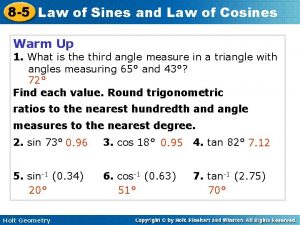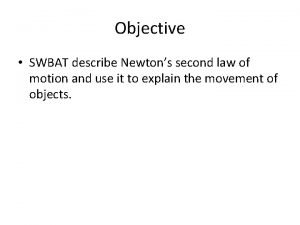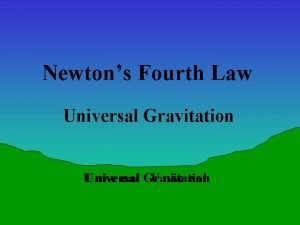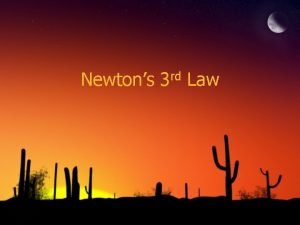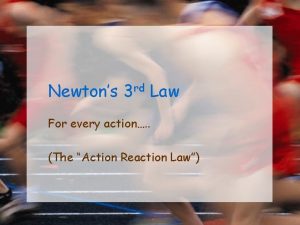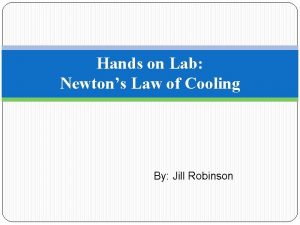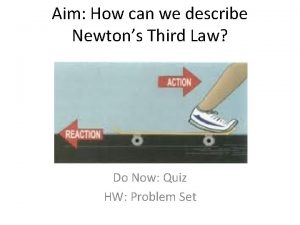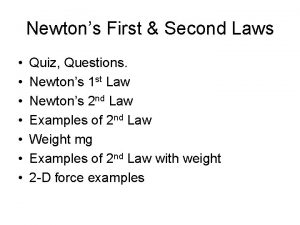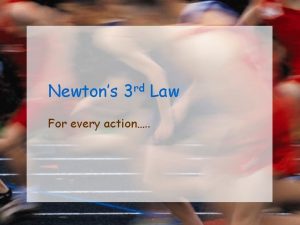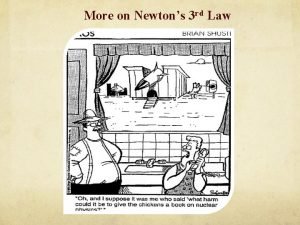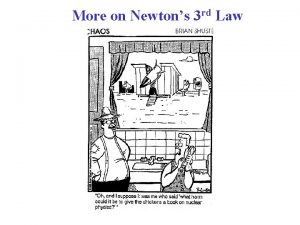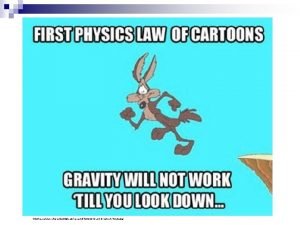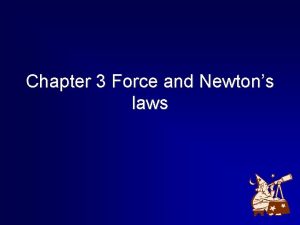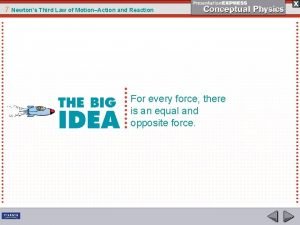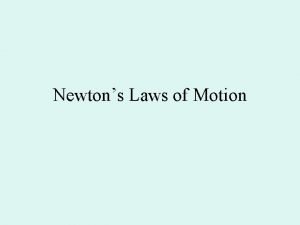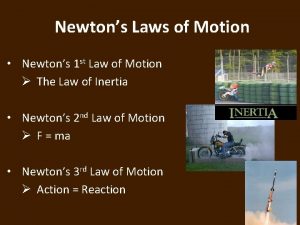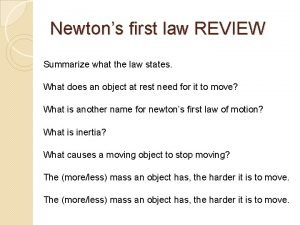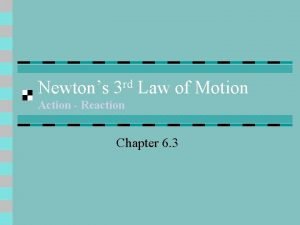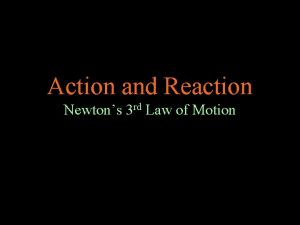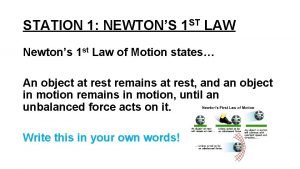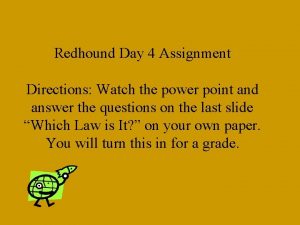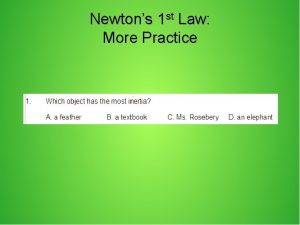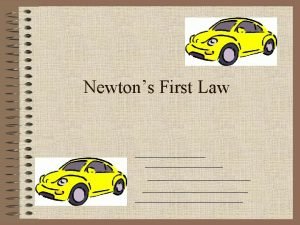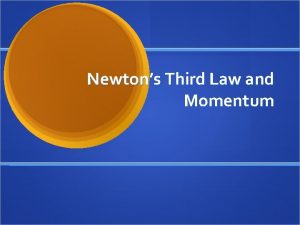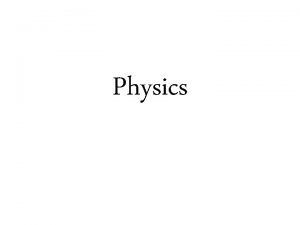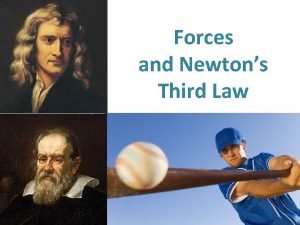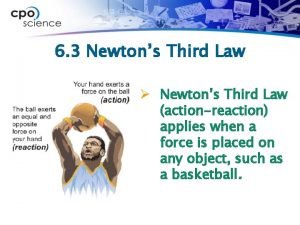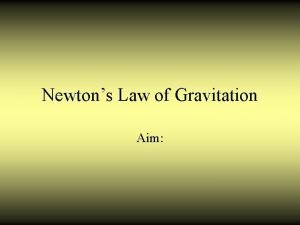Newtons 3 rd Law More Practice Newtons 3






































- Slides: 38

Newton’s 3 rd Law: More Practice

Newton’s 3 rd Law: More Practice

Newton’s 3 rd Law: More Practice

Newton’s 3 rd Law: More Practice

Newton’s 3 rd Law: More Practice

Newton’s 3 rd Law: More Practice

Newton’s 3 rd Law: More Practice

Newton’s 3 rd Law: More Practice

An Introduction to Friction: Student Learning Goal Students will be able to perform an investigation to determine the factors affecting static and kinetic friction, and to determine the corresponding coefficient of friction between an everyday object and the surface with which it is in contact. (C 2. 3)

An Introduction to Friction SPH 4 C

Weight Recall that the gravitational force acting on an object is also called the weight.

Weight Recall that the gravitational force acting on an object is also called the weight. Its magnitude is equal to: where m is mass, measured in kg, and g = 9. 8 m/s 2.

Weight Recall that the gravitational force acting on an object is also called the weight. Its magnitude is equal to: where m is mass, measured in kg, and g = 9. 8 m/s 2. Weight is therefore measured in Newtons.

The Normal Force Recall that the normal force is the force acting to keep objects apart.

The Normal Force Recall that the normal force is the force acting to keep objects apart. For an object on a horizontal surface with no vertical applied force, the normal force will be equal to _____. FN e. g. a box pushed rightward across a table Ff FA Fg

The Normal Force Recall that the normal force is the force acting to keep objects apart. For an object on a horizontal surface with no vertical applied force, the normal force will be equal to the weight. FN e. g. a box pushed rightward across a table Ff FA Fg

The Normal Force Recall that the normal force is the force acting to keep objects apart. For an object on a horizontal surface with no vertical applied force, the normal force will be equal to the weight (since the vertical forces must balance). FN e. g. a box pushed rightward across a table Ff FA Fg

FN not equal to Fg If there is a vertical applied force, the normal force will not equal the weight. Example A 5 kg book is resting on the table. If Selma is pushing down on the book with a force of 20 N, what is the normal force the table is exerting on the book?

FN not equal to Fg Example A 5 kg book is resting on the table. If Selma is pushing down on the book with a force of 20 N, what is the normal force the table is exerting on the book? FN = ? FA= 20 N Fg=(5 kg)(9. 8 m/s 2) = 50 N

FN not equal to Fg Example A 5 kg book is resting on the table. If Selma is pushing down on the book with a force of 20 N, what is the normal force the table is exerting on the book? FN = ? FA= 20 N The normal force must be 70 N [up]. Fg=(5 kg)(9. 8 m/s 2) = 50 N

Direction of FN Note that the normal force is always perpendicular to the surface. If the surface is vertical (e. g. a magnetic board to which a magnet is attached), the normal force must be horizontal.

Friction Recall that friction is the force acting to oppose any (attempted) motion and is therefore always opposite in direction to the attempted motion. The magnitude of the force of friction will depend on the properties of the surfaces in contact

Friction Recall that friction is the force acting to oppose any (attempted) motion and is therefore always opposite in direction to the attempted motion. The magnitude of the force of friction will depend on the properties of the surfaces in contact and on the normal force acting on the object attempting to move.

Mu The magnitude of the frictional force is given by:

Mu The magnitude of the frictional force is given by: where (mu) is the coefficient of friction, determined by the properties of the surfaces in contact.

Mu The magnitude of the frictional force is given by: where (mu) is the coefficient of friction, determined by the properties of the surfaces in contact. is dimensionless (no units) and is ≤ 1 (approx. ).

Mu Examples E. g. ● For steel on wood, (kinetic) = 0. 25 k s (static) = 0. 45 Note that s > k : it’s harder to get things moving than keep things moving.

Mu Examples E. g. ● For steel on wood, (kinetic) = 0. 25 k s (static) = 0. 45 ● For steel on ice, (kinetic) = k s (static) =

Mu Examples E. g. ● For steel on wood, (kinetic) = 0. 25 k s (static) = 0. 45 ● For steel on ice, (kinetic) = 0. 010 k s (static) = 0. 10 ● For rubber on dry concrete, (kinetic) = k s (static) =

Mu Examples E. g. ● For steel on wood, (kinetic) = 0. 25 k s (static) = 0. 45 ● For steel on ice, (kinetic) = 0. 010 k s (static) = 0. 10 ● For rubber on dry concrete, (kinetic) = k 1. 0 s (static) = 1. 1

Example Problem A 1200 -kg car without ABS brakes is skidding on dry concrete. What is the magnitude of the force of friction acting on the car?

Example Problem A 1200 -kg car without ABS brakes is skidding on dry concrete. What is the magnitude of the force of friction acting on the car?

Example Problem A 1200 -kg car without ABS brakes is skidding on dry concrete. What is the magnitude of the force of friction acting on the car?

Example Problem A 1200 -kg car without ABS brakes is skidding on dry concrete. What is the magnitude of the force of friction acting on the car?

ABS Brakes If the car does have ABS brakes, the car’s tires will continue to roll and grip the road while stopping and the relevant coefficient will be that of static friction:

ABS Brakes If the car does have ABS brakes, the car’s tires will continue to roll and grip the road while stopping and the relevant coefficient will be that of static friction:

ABS Brakes If the car does have ABS brakes, the car’s tires will continue to roll and grip the road while stopping and the relevant coefficient will be that of static friction: i. e. there is more force stopping the car when the tires are rolling and not sliding

More Practice Static and Kinetic Friction Lab
 More more more i want more more more more we praise you
More more more i want more more more more we praise you More more more i want more more more more we praise you
More more more i want more more more more we praise you Law of sines and cosines quiz part 1
Law of sines and cosines quiz part 1 Newton's first law and second law and third law
Newton's first law and second law and third law Newton's first law
Newton's first law Boyle's law charles law avogadro's law
Boyle's law charles law avogadro's law Avogadro's law constants
Avogadro's law constants Newtons 3 rd law of motion
Newtons 3 rd law of motion Inertia in soccer
Inertia in soccer Describe newtons second law
Describe newtons second law Examples of newtons first law
Examples of newtons first law Newtons fourth law
Newtons fourth law Newtons 3 rd law of motion
Newtons 3 rd law of motion Newtons 3 rd law of motion
Newtons 3 rd law of motion Newtons 3 rd law
Newtons 3 rd law Newtons 3 rd law
Newtons 3 rd law Newton’s cooling law
Newton’s cooling law Describe newtons third law
Describe newtons third law Third law of thermodynamics derivation
Third law of thermodynamics derivation Newtons 1 law
Newtons 1 law Newton’s 3rd law
Newton’s 3rd law Newtons law quiz
Newtons law quiz Newtons 3 rd law of motion
Newtons 3 rd law of motion Newtons 3 rd law
Newtons 3 rd law Action reaction forces
Action reaction forces Newtons 3 rd law
Newtons 3 rd law Newtons 3 rd law example
Newtons 3 rd law example Newton's second law meme
Newton's second law meme Section 3 using newtons laws
Section 3 using newtons laws Newton's third law
Newton's third law Newton's third law
Newton's third law Newtons nd law
Newtons nd law First law of motion facts
First law of motion facts Newtons 1 st law
Newtons 1 st law Mustafa sheikh
Mustafa sheikh Newtons 3 rd law of motion
Newtons 3 rd law of motion Newtons 3 rd law of motion
Newtons 3 rd law of motion Station +1
Station +1 Motion examples in everyday life
Motion examples in everyday life


